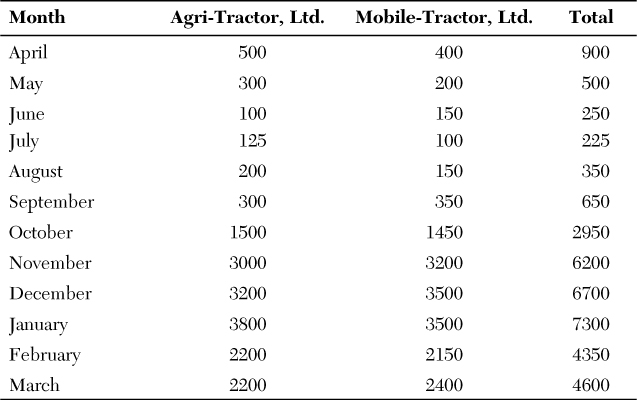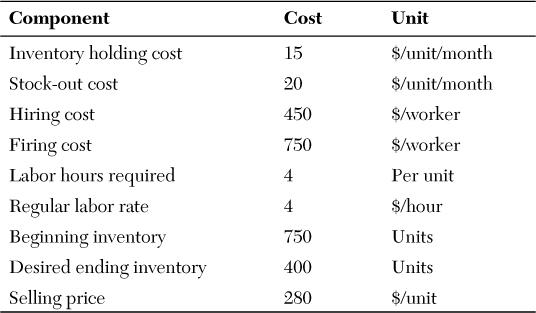The Interface between Demand Management and Production Strategies at TractParts
Abhishek Shinde† and Dileep More‡
† Indian Institute of Management, Calcutta, India; [email protected]
‡ Indian Institute of Management, Calcutta, India; [email protected]
Mr. Alex is the head of operations at TractParts Pvt. Ltd., a well-known Indian manufacturer of pumps, engines, electric motors, and transformers. The company is one of India’s earliest industrial groups, established in 1980, which has grown to become a big player within Indian manufacturing. Under the supervision of Mr. Alex, TractParts has been supplying modern tractor engines to leading tractor manufacturing firms such as Agri-Tractor, Ltd. and Mobile-Tractor, Ltd. The bulk of demand for tractors comes during the months from October to March. The demand for tractor engines fluctuates throughout the year. Table 1 shows the orders placed with TractParts by the firms Agri-Tractor, Ltd. and Mobile-Tractor, Ltd. in advance, based on their own forecasting models.
To meet demand, the company can follow either a chase strategy or a level strategy. With a chase strategy, monthly production mirrors the total demand in that month, and to follow this strategy, the company can hire new employees during higher demand periods and lay off employees during lower demand periods. This strategy significantly reduces inventory carrying costs. On the other hand, with a level strategy, the company always produces an amount equal to the average demand per month. Excess units are stored as inventory, while all stockouts are backlogged and supplied from the following months’ production. This strategy particularly saves on employee hiring and layoff costs. Moreover, to assure equal treatment, backorders are allocated to customers in direct proportion to the orders that they placed.
Currently, there are 100 workers in the TractParts manufacturing facility, and a total of 200 working hours (8 hours/day × 25 days/month) are available per worker per month. Because of strict government policies, the company cannot allow overtime.
Mr. Alex is concerned about the fluctuating demand and understands that these companies can change their demand pattern based on promotions and discounts offered to them. In order to enhance the total profit, Mr. Alex wants to optimize costs while meeting the demand pattern. He has therefore asked one of his associates to find out the associated costs and the cost structure. The associate has presented the cost structure for the engine manufacturing line as shown in Table 2.
Mr. Alex had asked the associate to explore the possibility of offering a discount to the tractor manufacturers. Mr. Alex was informed that a maximum 10% discount could be offered per company policy, and the discount would be offered for only one month. The associate also pointed out that whenever such kinds of discounts are offered, the tractor manufacturers have a tendency to order more units in that month. However, some of that demand increase merely represents a shift from later months (early buying), as opposed to representing brand new demand.
After examining some previous data, Mr. Alex has made the following observations. For Agri-Tractor, Ltd., a 10% decrease in price for a particular month results in a 45% increase in the demand for the same month followed by a 15% decrease in demand for each of the next two months. And in the case of Mobile-Tractor, Ltd., a 10% decrease in price for a particular month results in an 80% increase in demand for the same month followed by a 25% decrease in demand for each of the next two months. However, Mr. Alex also observed that if TractPart offers a discount in the final two months of the financial year, there is no change in the demand pattern since there is a very fixed demand of tractors at the end of season.
Mr. Alex faces a unique problem, as TractParts has proven itself over the years and is considered a symbol of quality, reliability, and accountability. Being a part of this value system, Mr. Alex knows that any unfair treatment of the tractor manufacturers will not be tolerated. Mr. Alex has a meeting with the company’s Senior Vice President tomorrow morning. He is concerned about which production policy should be adopted and when the 10% discount should be offered. Help Mr. Alex make the right decision by focusing on the following questions.
Questions
1. Estimate the profit made by TractParts when it follows a level strategy and no discount is offered to the tractor manufacturing firms.
2. Estimate the profit made by TractParts when it follows a chase strategy and no discount is offered to the tractor manufacturing firms.
3. Estimate the profit made by TractParts when it follows a level strategy and a 10% discount is offered to the tractor manufacturing firms in October.
4. Find out the month having the peak demand in which a 10% discount can be offered to the tractor manufacturing firms when TractParts follows a level strategy. (Hint: Estimate the profit made by TractParts when it follows a level strategy and a 10% discount has been offered to the tractor manufacturing firms in various months.)
5. Estimate the profit made by TractParts when it follows a chase strategy and a 10% discount is offered to the tractor manufacturing firms in October.
6. Find out the month having the peak demand in which a 10% discount can be offered to the tractor manufacturing firms when TractParts follows a chase strategy. (Hint: Estimate the profit made by TractParts when it follows a chase strategy and a 10% discount has been offered to the tractor manufacturing firms in various months.)


